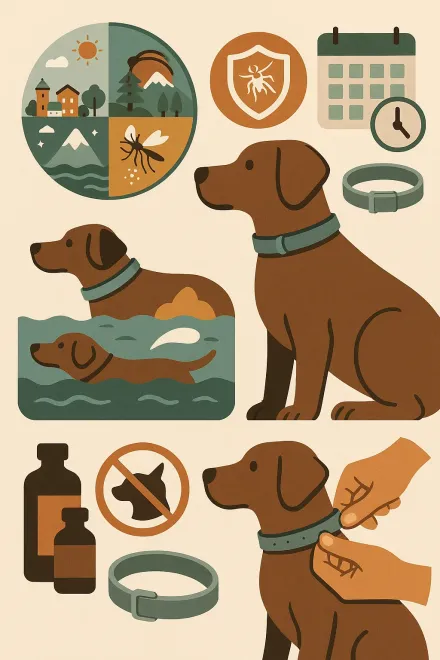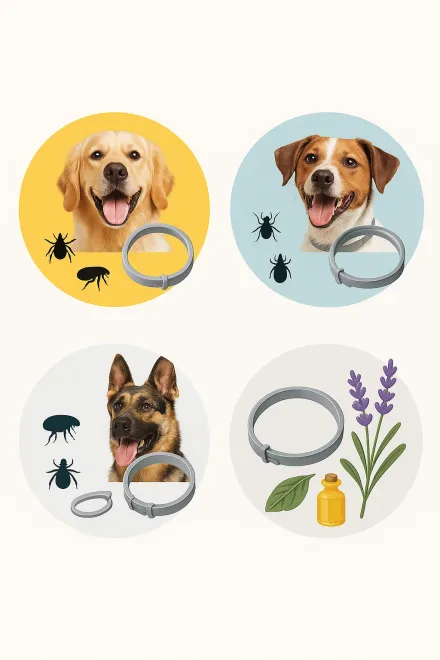What Is the Best Flea and Tick Collar for Dogs?
Choosing the best flea and tick collar for dogs is not just about price or brand—it’s about understanding your dog’s needs and the environment they live in. Flea and tick collars are one of the most convenient and long-lasting ways to protect pets from fleas, ticks, mosquitoes, and sandflies—parasites that not only cause itching and discomfort but can also transmit serious diseases like canine leishmaniasis and Lyme disease.
The market is full of options, and while many seem similar, the truth is they differ greatly in what parasites they protect against, how long they last, and where they work best. Some collars are ideal for rural areas, others for urban environments, and some are specially formulated to prevent specific diseases. In this guide, we’ll break down how these collars work, key features to look for, and which models are most recommended by veterinarians.
View top-rated flea and tick collars on Amazon
What Is a Flea and Tick Collar and How Does It Work?
A flea and tick collar is designed to release active ingredients with insecticidal and/or repellent properties in a controlled, continuous manner. The goal is to protect dogs from external parasites. These collars are typically made from polymer materials infused with the active ingredient, which spreads gradually across the dog’s skin and coat, providing full-body protection.
There are three main modes of action:
- Repellency: prevents parasites from biting or attaching by driving them away before contact.
- Lethal action: kills the parasite on contact, before it can feed.
- Combined protection: offers both benefits, ideal for high-risk areas.
Most chemical collars use active ingredients like deltamethrin, imidacloprid, or flumethrin. The choice depends on the target parasite, desired duration, and the dog’s tolerance. Unlike spot-on treatments or sprays, a flea and tick collar can provide several months of protection without frequent reapplication.
Key Factors for Choosing the Best Flea and Tick Collar
Before buying, consider the following factors to ensure the collar is both effective and safe for your dog:
- Types of parasites in your area: A dog in a cool northern city faces different risks than one in a warm coastal region with high sandfly activity.
- Protection duration: Some collars last 4 months, others up to 8 months.
- Water resistance: Essential if your dog swims or spends time outdoors.
- Safety: Always choose a product approved by veterinary authorities.
- Compatibility with other pets: Certain ingredients like deltamethrin are toxic to cats.
- Fit and comfort: It should fit snugly without causing irritation.
The best collar isn’t always the most expensive—it’s the one that suits your dog’s lifestyle and health needs.


Top Recommended Flea and Tick Collars for Dogs
Based on effectiveness, safety, duration, and value for money, here are the top picks:
1. Scalibor
Best for high-risk areas with leishmaniasis. Contains deltamethrin and offers up to 6 months of protection against ticks, mosquitoes, and sandflies.
2. Seresto
Combines imidacloprid and flumethrin to protect for up to 8 months against fleas and ticks. Odorless and comfortable.
3. Foresto
Similar to Seresto, effective against fleas and ticks and water-resistant.
4. Natural collars
Use citronella or lavender. Less potent but useful as a complementary option.
Flea and Tick Collar FAQs
How long does a flea and tick collar last?
Duration depends on brand and model. For example, Scalibor can provide up to 6 months of protection, while Seresto and Foresto can last up to 8 months. Natural collars usually last 2–3 months. Always replace them on time, as the active ingredient loses effectiveness over time.
Are they safe for puppies?
Most flea and tick collars are safe for puppies from 7–8 weeks of age, but always check the manufacturer’s instructions. For very young or health-compromised puppies, your vet may suggest waiting or using milder alternatives like gentle spot-on treatments.
Do they protect against all parasites?
No. Some collars target ticks and mosquitoes, while others focus on fleas. Identify the main parasites in your area before choosing. In regions with leishmaniasis, a collar effective against sandflies is essential.
Can I use them with spot-on treatments?
In some cases, yes—especially in high-risk areas. But combining chemical treatments can increase the risk of irritation or toxicity, so only do so with veterinary supervision.
What if my dog has skin irritation?
If you notice redness, hair loss, excessive scratching, or behavioral changes, remove the collar immediately and wash the area with mild soap and water. Contact your vet to check for allergies or reactions.
Are natural collars just as effective?
No, but they can help as a supplement. Natural collars with citronella, lavender, or eucalyptus may repel some insects but don’t offer reliable protection against dangerous parasites like ticks or sandflies.
What if my dog gets the collar wet?
Water-resistant collars like Scalibor or Seresto are not affected by occasional water exposure. However, frequent baths or shampoo use can shorten their lifespan.
Is year-round use necessary?
It depends on your location. In warm or humid climates, parasites may be active year-round, so continuous protection is recommended. In colder areas, seasonal use may be enough.
What’s the difference between a flea and tick collar and a spot-on?
Collars release active ingredients for several months, while spot-ons require monthly application. Collars are more convenient for owners who prefer not to reapply treatments frequently.
Can a flea and tick collar prevent leishmaniasis?
Yes, if it contains an active ingredient effective against sandflies, such as deltamethrin in Scalibor. While no method is 100% effective, risk drops significantly when combined with other preventive measures.
